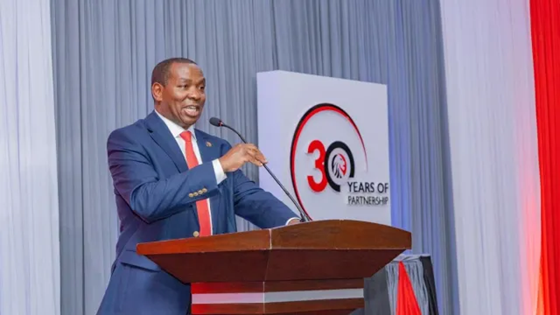Back in 1995, revenue personnel operated from cramped and different offices with little more than Remington typewriters and paper files stashed in closely guarded registries across separate departments.
Then, the tax departments collectively realised Ksh 122 billion, not a bad sum for a “developing” economy.
Fast-forward three decades later after all revenue departments were merged into one entity, Kenya Revenue Authority(KRA), now sits at Nairobi’s 140 metres tall and 38 floor Times Tower, where it conducts its operations via cloud-based systems, mobile apps and even WhatsApp chatbots.
With its latest tax collection peaking Ksh 2.5 trillion, a truly exponential jump, KRA revenues are credited for enabling the government to deliver key services to Kenyans from construction of schools, hospitals, roads, dams, offices among others as well as hiring of key personnel across ministries, county governments and other state agencies.
In line with its five year corporate plan, KRA has deployed new strategies to expand its tax base by setting up new departments to support small businesses to gain higher visibility and credibility that widens their capacity to take up new business opportunities especially from public entities. This creates an attractive pool of new taxpayers to be included in KRA’s tax base expansion scheme.
As part of giving Kenyans and local businesses an opportunity to execute their patriotic duty of paying taxes, KRA has established numerous departments and trained its personnel on modern ways to engage its customers. This is informed by KRA’s vision of endearing itself to taxpayers as a trade facilitator and not a tax collector.
Thanks to KRA’s digitisation and closer working relationship with taxpayers, Kenya’s tax collection rose to KES 1 trillion during the 2024/2015 period and continued its steady ascend to settle at KES 2.03 trillion during the 2021/2022 period.
Today it has already surpassed KES 2.5 trillion reforms, thanks to ongoing reforms to make compliance easier, from eliminating duplicate forms to streamlining port cargo clearance. Kenyans no longer regard paying taxes a punishment but rather a civic contribution.
Tech-Powered Taxation
KRA’s evolution has largely been technology-driven and taxpayer-centric. All transactions requiring payment of taxes and fees for licences are processed via online portals that brings all regulators to one window. This has simplified taxpayers’ burden of getting permits, clearance and inspection certificates. For this all payments are made via mobile payments and via online banking.
To further enhance KRA-taxpayer engagements, GavaConnect, an open API platform was launched inviting software developers to partner with KRA in creating Applications that simplify tax management and payments. So far 1,000 deve;opers have been enrolled on the platform where they can tap into GavaConnect’s suite of 16+ APIs to build tools, like PIN verification or e-Slip generation, that make tax tasks automatic.
KRA also links its eTIMS (electronic tax invoice management system) into this digital ecosystem, which means invoices for excisable goods can be tracked electronically and seamlessly with VAT reporting.
The result? Filing returns, claiming refunds and obtaining compliance certificates can all be done with a few clicks.
Innovations like automated VAT-return filling and even AI chatbots mean errors drop and waiting lines disappear. Human interaction has been drastically reduced and as KRA puts it, GavaConnect and eTIMS together have “simplified taxpayer engagement and secured government revenues,” cementing the Authority’s reputation as a leader in digital tax reform.
Looking Ahead
KRA is already exploring AI, data analytics and cloud systems to stay ahead of new economy trends. But the core message is clear: tax collection will be embedded in everyday Kenyan life, just as mobile money and e-commerce are, making compliance almost invisible but natural. KRA’s journey from a typewriter in 1995 to today’s digital-first authority mirrors Kenya’s rise as a tech-savvy economy. As Wattanga puts it, every reform is “a step towards a stronger, fairer and more prosperous Kenya”.
By embracing innovation while partnering with taxpayers, KRA is shaping a future where paying taxes feels like contributing to nation-building , completing its transformation from humble beginnings into a truly modern authority.
KRA’s Board Chairman, Hon. Ndiritu Muriithi (pictured) calls the 30th anniversary a “partnership” with staff, taxpayers and the tech community. He notes that KRA’s success “would not have been possible without the compliance of the public, and the support of development partners”.
Commissioner Wattanga echoes this collaborative spirit. At the jubilee celebrations he emphasized partnership and simplification:
“Expanding the tax base remains primary and critical,” he said, promising continued “collaboration and co-creation to enhance service delivery [and] strengthen partnerships with all stakeholders”.
In his view, modernizing KRA isn’t just about machines, it’s about trust. He stresses that building trust (“fairness, transparency, respect”) is as important as technology, and he frames taxation as a shared national responsibility.
When taxpayers see the Authority treating them with dignity and offering simpler processes, compliance naturally improves. In his own words, KRA is building “a taxation system that supports economic growth, innovation and job creation” through trust and service, not coercion






More Stories
IFC Channeling Africa’s Capital for Africa’s Sustainable Future
Naivas expands footprint in Redhill, reinforces commitment to affordability
Royal Nairobi to Host 100+ Golfers as Johnnie Walker Commits to East Africa Swing